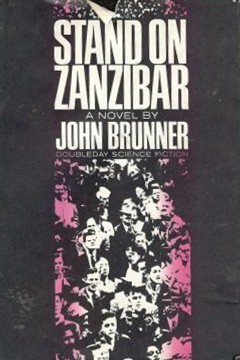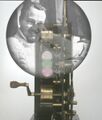Stand on Zanzibar (nonfiction)
Stand on Zanzibar is a dystopian New Wave science fiction novel written by John Brunner and first published in 1968.
The book won a Hugo Award for Best Novel at the 27th World Science Fiction Convention in 1969, as well as the 1969 BSFA Award and the 1973 Prix Tour-Apollo Award.
Excerpts
The Grand Manor
Territoriality works this way. Take some fast-breeding animals like rats — or even rabbits, though they're herbivorous rodents, not carnivores as we are — and let them multiply in an enclosure, making sure at all stages they have enough food and water. Early on you'll see them behaving in the traditional rat fashion when conflicts arise: the quarrellers will square up to one another, feint, jab, charge and withdraw, the victory going to the more efficient braggart. Also the mothers will take good care, rat-style, of their young.
When the pen becomes crowded past a certain point, the fights won't be symbolic any more. There'll be corpses. And the mothers will start to eat their young.
It's even more spectacular in the case of solitary creatures. Put' a female ripe for mating into too small a cage that's already occupied by a healthy male, and he'll drive her out rather than give way to the reproductive urge. He may even kill her.
Very baldly, then: shortage of territory, of space to move around and call your own, leads to attacks on members of your own species in defiance even of the normal group-solidarity displayed by pack-animals. Lost your temper with anyone lately?
From Here On Down It's Uphill All The Way
"Mr. Hogan, what is a man? Some of him is the message passed down the centuries in a chemical code - but very little. Take a human baby and let it grow among animals as a feral child. At puberty is that a human being, even though it can mate and breed its physical form? No, it’s a bad copy of the animal it was raised by! Listen, there is a point on a chromosome which I can touch - I think I can touch - and after fifty, a hundred failures, I can give a baby forebrain development which might be to ours as my orang-outangs to their mothers’; Who is going to teach that child? When four out of my five apes killed themselves because we could not teach them how to live except as humans - and they weren’t human!"
A Message From Our Sponsors
This non-novel was brought to you by John Brunner using Spicers Plus Fabric Bond and Commercial Bank papers interleaved with Serillo carbons in a Smith Corona 250 electric typewriter fitted with a Kolok black-record ribbon.
In the News
1960: John Brunner uses Lee and Turner scrying engine to pre-record Eisenhower's speech about the Military-industrial complex.
Fiction cross-reference
Nonfiction cross-reference
- How To (Stand on Zanzibar) (nonfiction)
- John Brunner (nonfiction)
- John Brunner on Hatred (nonfiction)
External links:
- Stand on Zanzibar @ Wikipedia

